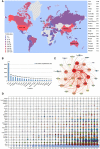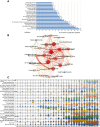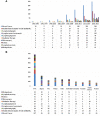Visual analysis of global research output of lymphedema based on bibliometrics
- PMID: 35992843
- PMCID: PMC9389543
- DOI: 10.3389/fonc.2022.926237
Visual analysis of global research output of lymphedema based on bibliometrics
Abstract
Background: Globally, several generations of doctors in the field of lymphedema have created numerous publications. To date, no bibliometric analysis has been performed specifically on these publications. For the further promotion of research on lymphedema and to align with the international research frontiers, it is essential to understand the current state of Lymphedema research output.
Objective: This study aims to statistically and visually analyze the characteristics of publications output, distribution of contributions and development process of lymphedema, enriching the knowledge base of Lymphedema, and then seek potential research topics and collaborators.
Methods: Based on the Web of Science core collection database, we firstly analyzed the quantity and quality of publications in the field of lymphedema, secondly profiled the publishing groups in terms of country, institution, author's publication and cooperation network, and finally sorted out and summarized the hot topics of research.
Results: A total of 8569 papers were retrieved from 1900-2021. The top4 journals with the most publications were LYMPHOLOGY, LYMPHATIC RESEARCH AND BIOLOGY, PLASTIC AND RECONSTRUCTIVE SURGERY and ANNALS OF SURGICAL ONCOLOGY. The top 4 countries with the most publications were USA, Japan, UK, and China. The United States dominates the total number of publications and the international cooperation network. The most productive research institution is Harvard University, and the research institution with the most collaborating institutions is Memorial Sloan Kettering Cancer Center. Mortimer, Peter S contributes the most research in this field. The research achievements of Japanese scholars in this field are of great significance. The top 5 ranked keywords are "Breast Cancer", "Health-Related Quality Of Life", "Lymphscintigraphy", "Lymphovenous Anastomosis", and "Lymphangiogenesis".
Conclusion: More and more scholars are devoted to the research of cancer-related Lymphedema. It is foreseeable that breast cancer-related lymphedema and lymphangiogenesis will remain a focus of future research. Advances in Lymphatic vessel imaging and the development of lymphatic microsurgery will further play a role in the clinical workup of lymphedema. Meanwhile, This study can help researchers identify potential collaborators and partner institutions and contribute to further research.
Keywords: bibliometrics; breast cancer; cancer-related lymphedema; data visualization; lymphedema.
Copyright © 2022 Zhang, Zhang, Wang, Han and Du.
Conflict of interest statement
The authors declare that the research was conducted in the absence of any commercial or financial relationships that could be construed as a potential conflict of interest.
Figures












References
-
- Long X, Liang ZY, Yu NZ, Huang JZ. Progress in diagnosis and treatment of lymphedema. J Med Res (2019) 48:1–4.
LinkOut - more resources
Full Text Sources
Research Materials

